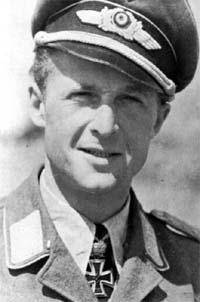
Back وولف ديتريش ويلكى ARZ Wolf-Dietrich Wilcke German Wolf-Dietrich Wilcke Spanish Wolf-Dietrich Wilcke French ヴォルフ=ディートリッヒ・ヴィルケ Japanese 볼프디트리히 빌케 Korean Wolf-Dietrich Wilcke Portuguese Вильке, Вольф-Дитрих Russian Wolf-Dietrich Wilcke Slovenian Вольф-Дітріх Вільке Ukrainian
Wolf-Dietrich Wilcke | |
|---|---|
 Wolf-Dietrich Wilcke | |
| Nickname(s) | "Fürst" |
| Born | 11 March 1913 Schrimm, Kingdom of Prussia, German Empire |
| Died | 23 March 1944 (aged 31) near Schöppenstedt, Free State of Brunswick, Nazi Germany |
| Cause of death | Killed in action |
| Buried | Cemetery in Mönchengladbach-Holt |
| Allegiance | |
| Service/ | Reichsheer (1934–35) Luftwaffe (1935–44) Condor Legion (1939) |
| Years of service | 1934–44 |
| Rank | Oberst (Colonel) |
| Unit | J/88, JG 53, JG 3 |
| Commands held | III./JG 53, JG 3 |
| Battles/wars | |
| Awards | Knight's Cross of the Iron Cross with Oak Leaves and Swords |
| Relations | Friedrich von Scotti (stepfather) |
Wolf-Dietrich Wilcke (11 March 1913 – 23 March 1944) was a German Luftwaffe pilot during World War II, a fighter ace credited with 162 enemy aircraft shot down in 732 combat missions. He claimed the majority of his victories over the Eastern Front, and 25 over the Western Front, including four four-engined bombers.
Born in Schrimm in the Province of Posen, Wilcke volunteered for military service in the Reichswehr of Nazi Germany in 1934.[Note 1] Initially serving in the Heer (Army), he transferred to the Luftwaffe (Air Force) in 1935. Following flight training, he was posted to Jagdgeschwader "Richthofen" (Fighter Wing "Richthofen") in April 1936. After an assignment as fighter pilot instructor he volunteered for service with the Condor Legion during the Spanish Civil War in early 1939. After his return from Spain, he was appointed Staffelkapitän (squadron leader) of the 7. Staffel (7th squadron) of Jagdgeschwader 53 (JG 53—53rd Fighter Wing). Following the outbreak of World War II, he claimed his first aerial victory on 7 November 1939. On 18 May 1940, during the Battle of France, he was shot down and taken prisoner of war. After the armistice with France, he returned from captivity and was appointed Gruppenkommandeur (group commander) of the III. Gruppe (3rd group) of JG 53 during the Battle of Britain, claiming 10 victories over England.
Wilcke then fought in the aerial battles of Operation Barbarossa, the German invasion of the Soviet Union. There, after 25 aerial victories, he was awarded the Knight's Cross of the Iron Cross on 6 August 1941. In September 1941, he relocated with his group to the Mediterranean Theater, where he was able to claim further victories. At the end of May 1942, he was transferred to the Stab (headquarters unit) of Jagdgeschwader 3 (JG 3—3rd Fighter Wing) "Udet", and that August he was appointed as its Geschwaderkommodore (wing commander). Following his 100th aerial victory on 6 September, he received the Knight's Cross of the Iron Cross with Oak Leaves. During the Battle of Stalingrad, on 17 December, he claimed his 150th aerial victory. On 23 December 1942, he was awarded the Knight's Cross of the Iron Cross with Oak Leaves and Swords, his total now 155 aerial victories.
Subsequent to the presentation of the Swords to his Knight's Cross, he was officially banned from operational flying. Occasionally he still flew combat missions and on 23 March 1944, flying in defense of the Reich, he claimed his 162nd and last aerial victory and was killed in action by United States Army Air Forces long-range P-51 Mustang fighters near Schöppenstedt, in Lower Saxony.
- ^ "Proklamation der Reichsregierung an das deutsche Volk bezüglich der Einführung der allgemeinen Wehrpflicht" [Proclamation of the German Government to the German people regarding the introduction of compulsory military service] (in German). Retrieved 19 April 2015.
Cite error: There are <ref group=Note> tags on this page, but the references will not show without a {{reflist|group=Note}} template (see the help page).
© MMXXIII Rich X Search. We shall prevail. All rights reserved. Rich X Search